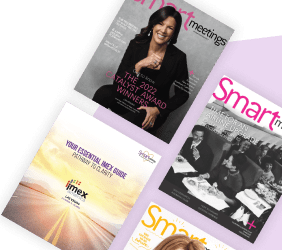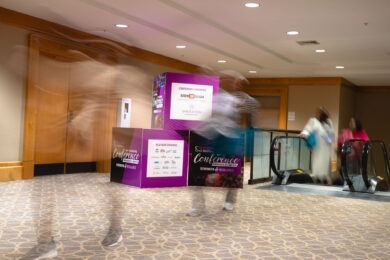If you’re heading to IMEX in time to catch Smart Monday, you might want to pop into Jon Bradshaw’s Meetology education session–you’ll likely be leaving with some invaluable tips that will boost your company’s communication and presentation skills.
In fact–if you’re heading to IMEX–you’ve already proven Bradshaw’s theory.
“You go to face-to-face meetings because they’re a deeper connection. It’s a fundamental desire as a human being,” says Bradshaw.
Research from the world of neuroscience suggests that we are wired to be social and that the need to connect, interact and communicate lies at the heart of what it is to be human. That is the foundation of The Meetology Lab. As part of Meeting Professionals International: Northern California Chapter’s (MPI NCC) October Education Program, his interactive workshop explored his company’s rich archive of behavior research to uncover science-based insights, as well as practice tips, tools and techniques, on how to maximize your performance professionally and personally by interacting more effectively with suppliers, customers, colleagues and friends.
“There is no other skill that relates directly to your success like interpersonal communication,” Bradshaw told the group of meeting planners.
He began his presentation by illustrating the irony of his public speaking role: He had introverted tendencies growing up with a fear of public speaking. A fear which, while incredibly common, is really a fear of social pain and public judgement. The workaround to becoming a more confident public speaker is multifaceted.
“You don’t need to be an extrovert to be good at social interaction” @Meetology CEO Jon Bradshaw @MPINCC @SmartMeetings #smartmtgs pic.twitter.com/otxPUFp3XR
— Loraine Burger (@SmartMtgsRaine) October 12, 2016
Steps for a Better Presentation (Meetology’s Interaction Model)
1. Prepare – How do you improve your confidence and manage thoughts and feelings that could get in the way of you connecting with others effectively?
Preparation was perhaps the largest focus during the MPI course: from mental attitude adjustment to ensuring you’re dressed for success and aren’t heading to a presentation on an empty stomach.
2. Connect – Yes, there really is scientific research (and an arsenal of tools and tricks) for making an instant connection with someone.
Did you know standing too far or too close to someone can give off the wrong impression? Or that talking negatively about someone that isn’t in the room can actually make those negative comments work against you?
3. Interact – What techniques can you use to make sure you have impact and come across clearly and confidently?
The physical environment in which a meeting takes place can have a significant impact on the meeting’s result, and encompasses everything from the temperature of the room to the amount of natural sunlight, greenery, chair set up, colors and artwork.
4. Resolve – What approaches and tools can you use to build trust, overcome conflict and resolve disagreements?
5. Influence – How can you tap into your values and beliefs to influence and persuade?
Corporate Masterclass Training
The Meetology Lab, whose staff is heavily populated by psychologists, offers day-long corporate training courses that get to the core of a company’s communication skills.
Group sizes range from 10 to 50–but Bradshaw says a group of about 30 is ideal. The group takes a deeper look at the above five steps and applies them to daily interactions.
When asked what most groups are hoping to solve by taking the class, Bradshaw responded, “We often find that they [the company] are overcomplicating things. It isn’t rocket science; at the core of their conflicts are simple communication issues.
Research-based, Yet Bizarre
Here are some of the fun–albeit weird–facts Bradshaw presented that illustrate how the environment affects people’s perceptions and social interactions:
In a test, people who were asked to donate money at the top of an escalator were more generous; a literal take on feeling a moral high-ground.
Walking through a doorway to present something new to someone can have a “clean slate” effect, as if past issues have been left behind. It’s called Event Horizon and can best be described the common phenomenon of walking into another room and suddenly forgetting your purpose.
Sitting at middle of long table rather than the head of the table is more more effective.
It’s no surprise that music affects mood, but consider this: In a study where music played over a speaker in a liquor store, purchase patterns for wine reflected the type of music playing.




